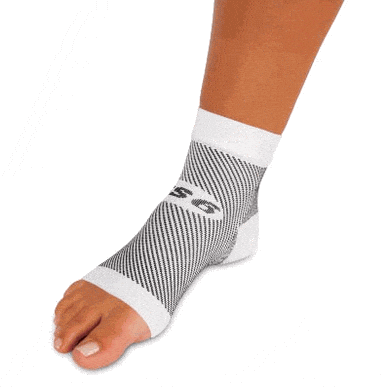Home gt; Foot Care gt; Plantar Fasciitis gt; 24/7 Plantar Fasciitis
Support
Plantar Fasciitis: Symptoms, Treatment and Prevention

In this final article in the two part series on Plantar Fasciitis, Brad Walker talks about the common symptoms of the painful sports injury as well as the utmost effective treatments once diagnosed. Brad also describes some very important precautionary measures that are crucial in avoiding Plantar Fasciitis. A foot injury such as plantar fasciitis generally occurs in one foot. Bilateral plantar fasciitis is uncommon and tends to be the consequence of a systemic arthritic condition that is remarkably rare among players. Males have problems with a somewhat increased occurrence of plantar fasciitis than females, perhaps as a result of higher weight in conjunction with greater quickness and earth impact, as well as less flexibility in the foot.Typically, the patient of plantar fasciitis activities pain upon growing after sleep, particularly the first rung on the ladder out of bed. Such pain is tightly localized at the bony landmark on the anterior medial tubercle of the calcaneus. In some instances, pain may prevent the athlete from walking in a standard heel-toe gait, creating an abnormal walk as means of compensation. Less common areas of pain include the forefoot, Achilles tendon, or subtalar joint.After a brief period of walking with this type of ft . injury, the pain usually subsides, but returns again either with vigorous activity or prolonged standing or walking. In the field, an improved gait or irregular stride style, along with pain during jogging or jumping activities are tell-tale signs or symptoms of plantar fasciitis and really should be given fast attention. Further signs of the personal injury include poor dorsiflexion (lifting the forefoot off the bottom) scheduled to a shortened gastroc organic, (muscles of the calf). Crouching in a full squat position with the sole of the ft . flat on the floor can be used as a test, as pain will preclude it for the athlete suffering from plantar fasciitis, triggering an elevation of the heel due to tension in the gastroc complex.TreatmentTreatment of plantar fasciitis may also be a slow and irritating process. A program of treatment should be undertaken with the help of someone licensed and knowledgeable about the affliction. Typically, plantar fasciitis will require at least six weeks or more to half a year of conservative treatment to be fully remedied. Should such efforts not provide pain relief to the athlete, more ambitious methods including surgery may be looked at.The initial goals of physical remedy ought to be to increase the passive flexion of the feet and improve overall flexibility in the foot and ankle, eventually leading to a full go back to normal function. Long term inactivity in strenuous sports is usually the price to be paid for thorough recovery. 50 percent measures can result in a serious condition, in some cases severely limiting athletic ability.As a large timeframe is spent during intercourse during sleeping time, it's important to ensure that the bed sheets at the foot of the bed do not constrict the feet, leading to plantar flexion where the foot is bent straight out with the toes pointing. This constricts and in that way shortens the gastroc organic, worsening the problem. A home heating pad positioned under the muscles of the leg for a few momemts prior to rising may help release tension, increase blood circulation in the lower leg and decrease pain. Also while asleep, a nighttime splint may be used in order to hold the ankle joint in a neutral position. This may aid in the therapeutic of the plantar fascia and ensure that the foot will not become flexed at night time.Careful attention to footwear is crucial in avoiding feet injuries. Every work should be made to wear comfortable shoes with proper arch support, fostering proper feet posture. Should arch facilitates prove inadequate, an orthotic boot should be considered. Fortunately, most conditions of plantar fasciitis answer well to non-operative treatment.Recovery times however differ enormously in one athlete to some other, depending on get older, overall health and physical condition as well as intensity of injury. A broad period between 6 weeks and six months is usually sufficient for proper therapeutic. Additionally, the method of treatment must be adaptable with regards to the details of a specific athlete?s injury. Methods that verify successful in a single patient, may well not improve the personal injury in another.Early treatment of ft . injuries typically includes the utilization of anti-inflammatory medication, icing, stretching activities, and heel inserts and splints. Cortisone shots may be necessary to achieve satisfactory recovery and retard infection. In later levels of the treatment process, typically following the first week, ice should be discontinued and substituted with warmth and massage.It is essential that any activity known to produce irritability or injury to the plantar fascia be immediately discontinued, including any activity involving repeated impact of the heel on a difficult surface, particularly, working. Should pain from the personal injury persist, additional diagnostic studies should be undertaken to rule out other, more exotic causes of heel pain including stress fractures, nerve compression injury, or collagen disorders of your skin.
Home gt; Foot Care gt; Plantar Fasciitis gt; 24/7 Plantar Fasciitis Support's Wallpaper
Related Images with Home gt; Foot Care gt; Plantar Fasciitis gt; 24/7 Plantar Fasciitis Support
This medical exhibit illustrates a cast, with another view of a

Foot corn treatment home remedy,walkfit orthotic insoles,plantar warts

Plantar Fasciitis, Plantar Fasciitis Treatment and Exercises For

treatment the most common surgical procedure for plantar fasciitis













0 komentar: